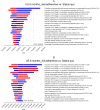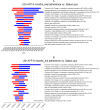Hepatocellular carcinoma surveillance based on the Australian Consensus Guidelines: a health economic modelling study
- PMID: 37076870
- PMCID: PMC10116722
- DOI: 10.1186/s12913-023-09360-4
Hepatocellular carcinoma surveillance based on the Australian Consensus Guidelines: a health economic modelling study
Abstract
Background: Hepatocellular carcinoma (HCC) is the fastest increasing cause of cancer death in Australia. A recent Australian consensus guidelines recommended HCC surveillance for cirrhotic patients and non-cirrhotic chronic hepatitis B (CHB) patients at gender and age specific cut-offs. A cost-effectiveness model was then developed to assess surveillance strategies in Australia.
Methods: A microsimulation model was used to evaluate three strategies: biannual ultrasound, biannual ultrasound with alpha-fetoprotein (AFP) and no formal surveillance for patients having one of the conditions: non-cirrhotic CHB, compensated cirrhosis or decompensated cirrhosis. One-way and probabilistic sensitivity analyses as well as scenario and threshold analyses were conducted to account for uncertainties: including exclusive surveillance of CHB, compensated cirrhosis or decompensated cirrhosis populations; impact of obesity on ultrasound sensitivity; real-world adherence rate; and different cohort's ranges of ages.
Results: Sixty HCC surveillance scenarios were considered for the baseline population. The ultrasound + AFP strategy was the most cost-effective with incremental cost-effectiveness ratios (ICER) compared to no surveillance falling below the willingness-to-pay threshold of A$50,000 per quality-adjusted life year (QALY) at all age ranges. Ultrasound alone was also cost-effective, but the strategy was dominated by ultrasound + AFP. Surveillance was cost-effective in the compensated and decompensated cirrhosis populations alone (ICERs < $30,000), but not cost-effective in the CHB population (ICERs > $100,000). Obesity could decrease the diagnostic performance of ultrasound, which in turn, reduce the cost-effectiveness of ultrasound ± AFP, but the strategies remained cost-effective.
Conclusions: HCC surveillance based on Australian recommendations using biannual ultrasound ± AFP was cost-effective.
Keywords: Alpha-fetoprotein; Cost-effectiveness; Hepatocellular carcinoma; Surveillance; Ultrasound.
© 2023. The Author(s).
Conflict of interest statement
The authors declare that they have no competing interests.
Figures




Similar articles
-
Cost Effectiveness of Hepatocellular Carcinoma Surveillance After a Sustained Virologic Response to Therapy in Patients With Hepatitis C Virus Infection and Advanced Fibrosis.Clin Gastroenterol Hepatol. 2019 Aug;17(9):1840-1849.e16. doi: 10.1016/j.cgh.2018.12.018. Epub 2018 Dec 20. Clin Gastroenterol Hepatol. 2019. PMID: 30580095
-
Cost-Utility Analysis of Non-Contrast Abbreviated Magnetic Resonance Imaging for Hepatocellular Carcinoma Surveillance in Cirrhosis.Gut Liver. 2024 Jan 15;18(1):135-146. doi: 10.5009/gnl230089. Epub 2023 Aug 10. Gut Liver. 2024. PMID: 37560799 Free PMC article.
-
Duration and cost-effectiveness of hepatocellular carcinoma surveillance in hepatitis C patients after viral eradication.J Hepatol. 2022 Jul;77(1):55-62. doi: 10.1016/j.jhep.2022.01.027. Epub 2022 Feb 12. J Hepatol. 2022. PMID: 35157959 Free PMC article.
-
Surveillance Imaging and Alpha Fetoprotein for Early Detection of Hepatocellular Carcinoma in Patients With Cirrhosis: A Meta-analysis.Gastroenterology. 2018 May;154(6):1706-1718.e1. doi: 10.1053/j.gastro.2018.01.064. Epub 2018 Feb 6. Gastroenterology. 2018. PMID: 29425931 Free PMC article.
-
Alpha-Fetoprotein (AFP) and AFP-L3 Is Most Useful in Detection of Recurrence of Hepatocellular Carcinoma in Patients after Tumor Ablation and with Low AFP Level.Viruses. 2022 Apr 8;14(4):775. doi: 10.3390/v14040775. Viruses. 2022. PMID: 35458505 Free PMC article. Review.
Cited by
-
A Health Economic Evaluation of Routine Hepatocellular Carcinoma Surveillance for People with Compensated Cirrhosis to Support Australian Clinical Guidelines.MDM Policy Pract. 2025 Jun 26;10(1):23814683251344962. doi: 10.1177/23814683251344962. eCollection 2025 Jan-Jun. MDM Policy Pract. 2025. PMID: 40584144 Free PMC article.
-
Opportunities to improve surveillance of hepatocellular carcinoma in Australia.Med J Aust. 2025 Jul 21;223(2):61-67. doi: 10.5694/mja2.52691. Epub 2025 Jun 8. Med J Aust. 2025. PMID: 40484713 Free PMC article. No abstract available.
References
-
- Mortality GBD, Causes of Death C. Global, regional, and national life expectancy, all–cause mortality, and cause–specific mortality for 249 causes of death, 1980–2015: a systematic analysis for the global burden of Disease Study 2015. Lancet. 2016;388(10053):1459–544. doi: 10.1016/S0140-6736(16)31012-1. - DOI - PMC - PubMed
MeSH terms
Substances
LinkOut - more resources
Full Text Sources
Medical

